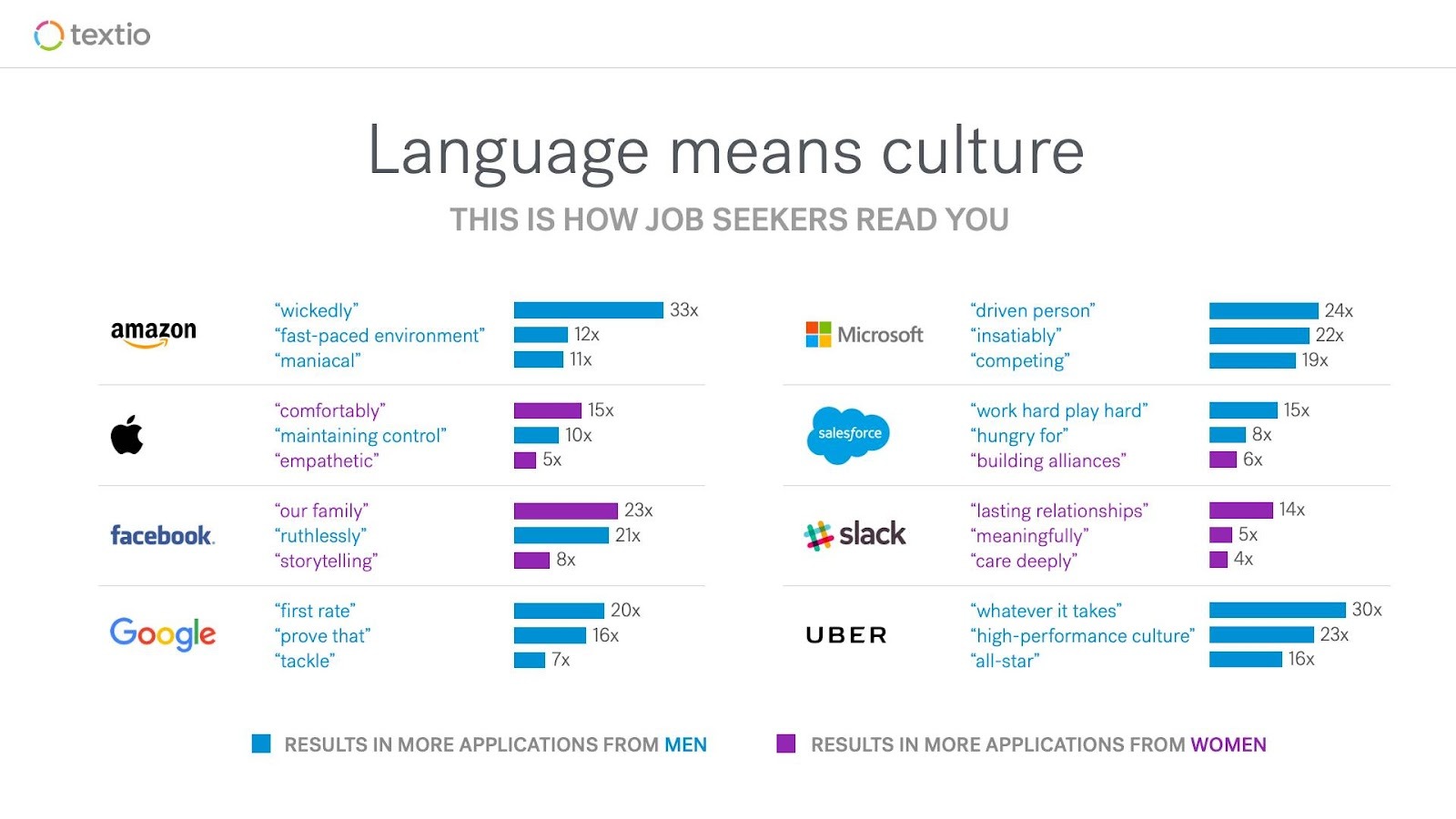Textio, the software company I founded, initially offered a product to help people write more effective job posts. In order to create the product, our team continually collected millions of job posts to assess which phrases performed well with job seekers.
At any given moment, we had deep insight into the hiring language that all kinds of organizations and geographies were using locally and globally. This data became the foundation of our first software product. It also became the foundation of dozens of viral data stories that we published to get the word out about our product.
Among the many successful data stories that Textio told in our first few years, one from 2017 had more impact on our business than any other. Internally, we called it the Top Phrases story.
The concept was simple. We analyzed the career sites of eight of the most famous tech companies in the world. As you might expect, job posts at these companies have a lot in common. But we were interested in something else: What made each company distinct? Could you see the cultural differences between Apple and Amazon play out in the language in their job posts?
For each company on our list, we looked at the statistical outliers: the distinctive phrases that showed up in their job posts way more often than the benchmark set by the rest of the group. For instance, we saw that Amazon used the word maniacal 11 times more than the other companies. Facebook used the word ruthlessly 21 times more often than the others. Uber, which at the time was led by Travis Kalanick and famous for its take-no-prisoners culture, used the phrase whatever it takes 30 times more often than any of the other companies in our data set.
In many cases, our findings reinforced common stereotypes about each company's reputation. By looking at data hiding in plain sight, we were able to tell a compelling story about the connection between a company's language choices and its culture on the ground.

We cross-referenced these language patterns with Textio's statistical data about gender bias in job applicant pools. We packaged up the full set of insights, published them to our blog, and told the world about it. The Wall Street Journal prominently covered the story and called all the companies on our list for comment on the data. The story stayed in heavy rotation in the tech and business news cycle for weeks to come.
Within three days of publishing the Top Phrases story, it had driven more new leads to our sales team than all our other content had done combined.
Why did the Top Phrases story work?
You can't always predict which stories will go viral and drive your business forward, but you can make some educated guesses. Top Phrases had a lot of things going for it. First, it tapped into what people already cared about; at the time, everyone was talking about gender bias in tech companies.
Second, the insights themselves reinforced people's pre-existing confirmation bias. People already held strong beliefs about the cultures of famous companies like Microsoft and Google, and Textio's data "proved" the truth of those beliefs.
Both of these factors contributed to the virality of Top Phrases. But neither of these elements on their own would have driven real business value for Textio without another key factor: the Top Phrases story aligned closely with the software product that we sold.
Textio's product premise was that job candidates can tell a lot about a company's culture by the language in their job posts, so the language you use changes who applies to your jobs. Our customers subscribed to Textio to fix their language and change the composition of their applicant pools.
Top Phrases drove value for Textio's business because the story had the greatest appeal to the people we wanted most as customers. Writing the data story for virality ensured that as many of those people as possible would see it.
Using data stories to drive your business forward
We recently convened a group of OpCo founders to discuss how to use data storytelling to build customer awareness and traction. As the Textio example illustrates, there are a few critical principles behind every successful data story:
- Start with a hypothesis. In my example, our hypothesis turned out to be true, which made for an interesting story. But if it had turned out to be false, that would have made an interesting story too. Start with a hypothesis that will make a good story either way.
- Use confirmation bias. Sometimes, good data stories prove people wrong by present surprising insights that make people take notice. But the best data stories, the ones that go viral most often, prove people right. Everyone loves to say “I told you so.” In the Textio example, we knew that some kinds of phrases were more likely to make our story go viral than others. Learning that Amazon uses the phrase e-commerce 1000 times more often than Salesforce is not interesting. But learning that they say maniacal 11 times more often than the rest of the tech industry combined? That's a story that lets a lot of people say “I told you so” about a company culture that is famed for its intensity.
- Align with your customers and your value prop. Even the most viral story won’t help your business if it speaks to the wrong audience. Also, the most viral stories do not overtly sell your product; aim to reinforce your product’s value prop without explicitly selling it. Audiences are very skeptical of sales pitches, but they love data whose independent value they understand.
Happy storytelling!



